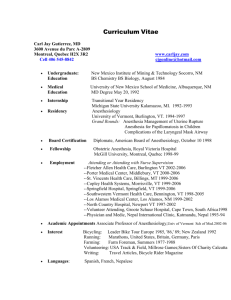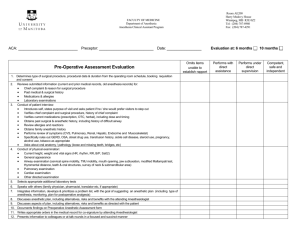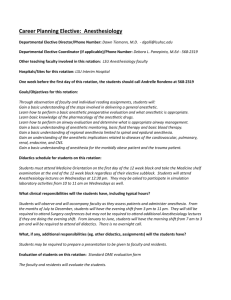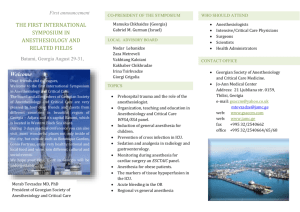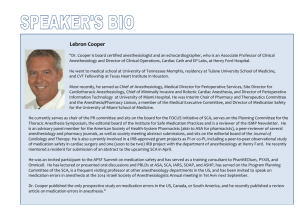Guidelines for Patient Care in Anesthesiology
advertisement
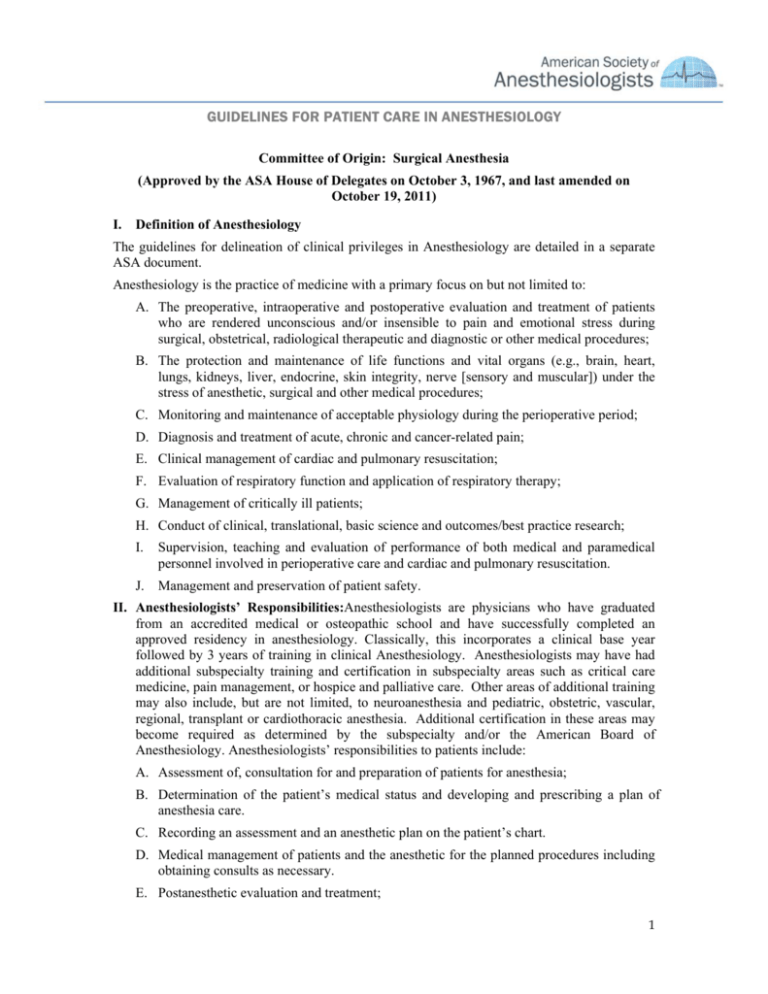
GUIDELINES FOR PATIENT CARE IN ANESTHESIOLOGY Committee of Origin: Surgical Anesthesia (Approved by the ASA House of Delegates on October 3, 1967, and last amended on October 19, 2011) I. Definition of Anesthesiology The guidelines for delineation of clinical privileges in Anesthesiology are detailed in a separate ASA document. Anesthesiology is the practice of medicine with a primary focus on but not limited to: A. The preoperative, intraoperative and postoperative evaluation and treatment of patients who are rendered unconscious and/or insensible to pain and emotional stress during surgical, obstetrical, radiological therapeutic and diagnostic or other medical procedures; B. The protection and maintenance of life functions and vital organs (e.g., brain, heart, lungs, kidneys, liver, endocrine, skin integrity, nerve [sensory and muscular]) under the stress of anesthetic, surgical and other medical procedures; C. Monitoring and maintenance of acceptable physiology during the perioperative period; D. Diagnosis and treatment of acute, chronic and cancer-related pain; E. Clinical management of cardiac and pulmonary resuscitation; F. Evaluation of respiratory function and application of respiratory therapy; G. Management of critically ill patients; H. Conduct of clinical, translational, basic science and outcomes/best practice research; I. Supervision, teaching and evaluation of performance of both medical and paramedical personnel involved in perioperative care and cardiac and pulmonary resuscitation. J. Management and preservation of patient safety. II. Anesthesiologists’ Responsibilities:Anesthesiologists are physicians who have graduated from an accredited medical or osteopathic school and have successfully completed an approved residency in anesthesiology. Classically, this incorporates a clinical base year followed by 3 years of training in clinical Anesthesiology. Anesthesiologists may have had additional subspecialty training and certification in subspecialty areas such as critical care medicine, pain management, or hospice and palliative care. Other areas of additional training may also include, but are not limited, to neuroanesthesia and pediatric, obstetric, vascular, regional, transplant or cardiothoracic anesthesia. Additional certification in these areas may become required as determined by the subspecialty and/or the American Board of Anesthesiology. Anesthesiologists’ responsibilities to patients include: A. Assessment of, consultation for and preparation of patients for anesthesia; B. Determination of the patient’s medical status and developing and prescribing a plan of anesthesia care. C. Recording an assessment and an anesthetic plan on the patient’s chart. D. Medical management of patients and the anesthetic for the planned procedures including obtaining consults as necessary. E. Postanesthetic evaluation and treatment; 1 GUIDELINES FOR PATIENT CARE IN ANESTHESIOLOGY F. On-site medical direction of any nonphysician who participates in the delivery of anesthesia care to the patient. This includes, but is not limited to, anesthesiologist assistants as well as certified registered nurse anesthetists. G. Perioperative pain management. H. All aspects of pain management when treating non-surgical pain. I. Management of the hospitalized patient and/or critically ill patient when practicing hospital or critical care medicine. J. Management of perioperative patient safety. K. Operating suite, ambulatory surgery center, and practice management. L. Setting standards and policies for the administration of sedation and anesthesia and procedural sedation throughout hospitals and ambulatory surgery centers. III. Guidelines for Anesthesia Care: A. The ASA has guidelines and advisories located on the ASA website (www.asahq.org) B. The same standards for and quality of anesthetic care should be available for: 1. All patients, 24 hours a day, seven days a week; 2. Emergency as well as elective patients; 3. Obstetrical, medical and surgical patients. C. Preanesthetic evaluation and preparation means that an anesthesiologist before the delivery of anesthesia care, is responsible for: 1. Reviewing the available medical record. 2. Interviewing [if possible, certain circumstances may prevent (e.g., emergent surgery, coma, etc)] and performing a focused examination of the patient to: a. Discuss the medical history, including previous anesthetic experiences and medical therapy. b. Assess those aspects of the patient’s physical condition that might affect decisions regarding perioperative risk and management. 3. Ordering and reviewing pertinent available tests and consultations as necessary for the delivery of anesthesia care. D. Perianesthetic care means being responsible for: 1. Re-evaluation of the patient immediately prior to induction; 2. Premedication and psychological support of patients prior to anesthesia. 3. Preparation and check of equipment, drugs, fluids and gas supplies; 4. Appropriate monitoring of the patient; 5. Selection and administration of anesthetic agents to render the patient insensible to pain, while providing a level of comfort and relaxation commensurate with the invasiveness and physiologic stress of the planned procedure; 2 GUIDELINES FOR PATIENT CARE IN ANESTHESIOLOGY 6. Support of life functions under the stress of anesthetic, surgical, obstetrical and radiological manipulations; 7. Recording the pertinent events of the procedure. E. Postanesthetic care means: 1. Ensuring availability of nursing personnel and equipment as required for safe postanesthetic care; 2. Ensuring transfer of care information pertinent to the patient’s specific needs and ensuring a safe transition; 3. Remaining with the patient as long as medically necessary and until the receiving health care provider has all the information needed to assume care; 4. Ensuring that the patient is discharged from the postanesthesia care unit in accordance with policies established by the Department of Anesthesiology. 5. Ensuring that the duration of surveillance in the postanesthesia care unit is determined by the status of the patient and the judgment of the anesthesiologist. 6. Conducting a postanesthesia evaluation, assessing patients for sequelae from anesthetic interventions and arranging for appropriate follow-up. IV. Additional Areas of Expertise: A. Resuscitation procedures B. Pulmonary care C. Critical care medicine D. Diagnosis and treatment of acute, chronic, and cancer-related pain E. Trauma and emergency care F. Management of cardiopulmonary bypass or bridges to care which include but are not limited to management of intra-aortic balloon pumps (IABP) or extra-corporeal membrane oxygenation (ECMO) G. Management of preadmission clinics for patients undergoing surgical, diagnostic or therapeutic procedures requiring care by an anesthesiologist H. Medical direction of day-of surgery and postanesthetic care units I. Perioperative medicine J. Transesophageal echocardiography K. Ultrasonography for regional anesthetics, vascular access as well as other patient physical assessments and procedures as required in perioperative period. L. Operating room management M. Perioperative performance improvement N. Regional anesthesia and analgesia O. Other specialized diagnostic or therapeutic procedures including but not limited to somatosensory or motor evoked potential monitoring and venovenous bypass 3 GUIDELINES FOR PATIENT CARE IN ANESTHESIOLOGY V. Quality Assurance: The anesthesiologist should participate in a planned program for evaluation of quality and appropriateness of the anesthetic care of patients and should participate in resolving identified problems. 4


